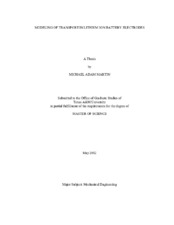| dc.description.abstract | Lithium ion battery systems are promising solutions to current energy storage needs due to their high operating voltage and capacity. Numerous efforts have been conducted to model these systems in order to aid the design process and avoid expensive and time consuming prototypical experiments. Of the numerous processes occurring in these systems, solid state transport in particular has drawn a large amount of attention from the research community, as it tends to be one of the rate limiting steps in lithium ion battery performance. Recent studies have additionally indicated that purposeful design of battery electrodes using 3D microstructures offers new freedoms in design, better use of available cell area, and increased battery performance.
The following study is meant to serve as a first principles investigation into the behaviors of 3D electrode architectures by monitoring concentration and cycle behaviors under realistic operating conditions. This was accomplished using computational tools to model the solid state diffusion behavior in several generated electrode morphologies. Developed computational codes were used to generate targeted structures under prescribed conditions of particle shape, size, and overall morphology. The diffusion processes in these morphologies were simulated under conditions prescribed from literature.
Primary results indicate that parameters usually employed to describe electrode geometry, such as volume to surface area ratio, cannot be solely relied upon to predict or characterize performance. Additionally, the interaction between particle shapes implies some design aspects that may be exploited to improve morphology behavior. Of major importance is the degree of particle isolation and overlap in 3D architectures, as these govern gradient development and lithium depletion within the electrode structures. The results of this study indicate that there are optimum levels of these parameters, and so purposeful design must make use of these behaviors. | en |


